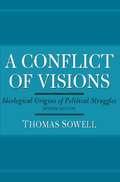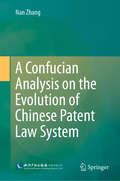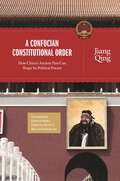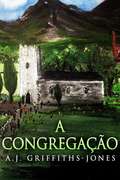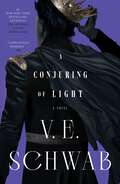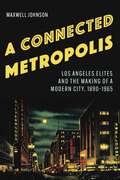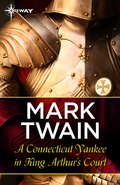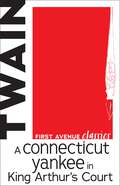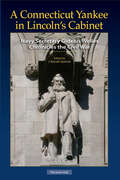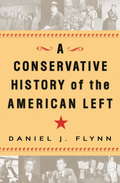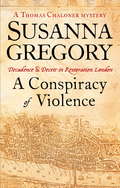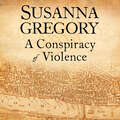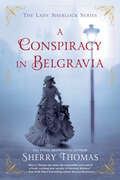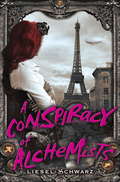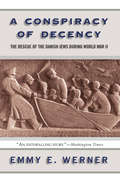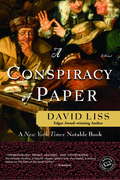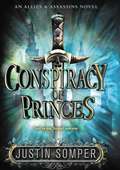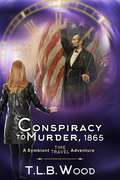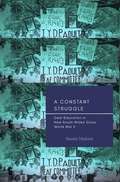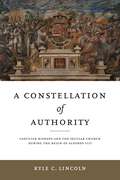- Table View
- List View
A Conflict of Visions: Ideological Origins of Political Struggles
by Thomas SowellIn this classic work, Thomas Sowell analyzes the two competing visions that shape our debates about the nature of reason, justice, equality, and power: the "constrained" vision, which sees human nature as unchanging and selfish, and the "unconstrained" vision, in which human nature is malleable and perfectible. He describes how these two radically opposed views have manifested themselves in the political controversies of the past two centuries, including such contemporary issues as welfare reform, social justice, and crime. Updated to include sweeping political changes since its first publication in 1987, this revised edition of A Conflict of Visions offers a convincing case that ethical and policy disputes circle around the disparity between both outlooks.
A Confucian Analysis on the Evolution of Chinese Patent Law System
by Nan ZhangThis book comprehensively discusses the main features of the Chinese patent law system, which not only legally ‘transplants’ international treaties into the Chinese context, but also maintains China’s legal culture and promotes domestic economic growth. This is the basis for encouraging creativity and improving patent law protection in China. The book approaches the evolution of the Chinese patent system through the ancient Chinese philosopher Confucius’s classic principle, offering readers a fresh new way to understand and analyze Chinese patent law reforms, while also outlining how Confucian insights could be used to improve the enforcement of patent law and overall intellectual property protection awareness in China. It examines ancient Chinese innovation history, explores intellectual property from a Confucian perspective, and discusses the roots of Chinese patent law, as well as the past three amendments and the trends in the ongoing fourth amendment. In addition to helping readers grasp the mentality behind the Chinese approach to patent law and patent protection, the book provides an alternative research methodology and philosophical approach by demonstrating Confucian analysis, which provides a more dynamic way to justify intellectual property in the academic world. Lastly, it suggests future strategies for local industries in the legal, cultural and sociological sectors in China, which provide benefits for domestic and overseas patent holders alike. The book offers a valuable asset for graduate students and researchers on China and intellectual property law, as well as general readers interested in Asian culture and the philosophy of law.
A Confucian Constitutional Order: How China's Ancient Past Can Shape Its Political Future (The Princeton-China Series #4)
by Jiang QingWhat a Confucian constitutional government might look like in China's political futureAs China continues to transform itself, many assume that the nation will eventually move beyond communism and adopt a Western-style democracy. But could China develop a unique form of government based on its own distinct traditions? Jiang Qing—China's most original, provocative, and controversial Confucian political thinker—says yes. In this book, he sets out a vision for a Confucian constitutional order that offers a compelling alternative to both the status quo in China and to a Western-style liberal democracy. A Confucian Constitutional Order is the most detailed and systematic work on Confucian constitutionalism to date.Jiang argues against the democratic view that the consent of the people is the main source of political legitimacy. Instead, he presents a comprehensive way to achieve humane authority based on three sources of political legitimacy, and he derives and defends a proposal for a tricameral legislature that would best represent the Confucian political ideal. He also puts forward proposals for an institution that would curb the power of parliamentarians and for a symbolic monarch who would embody the historical and transgenerational identity of the state. In the latter section of the book, four leading liberal and socialist Chinese critics—Joseph Chan, Chenyang Li, Wang Shaoguang, and Bai Tongdong—critically evaluate Jiang's theories and Jiang gives detailed responses to their views.A Confucian Constitutional Order provides a new standard for evaluating political progress in China and enriches the dialogue of possibilities available to this rapidly evolving nation. This book will fascinate students and scholars of Chinese politics, and is essential reading for anyone concerned about China's political future.
A Congregação
by A.J. Griffiths-JonesUma agitada cidade de mineração na Inglaterra dos anos 70 aguarda a chegada de seu novo vigário. As pessoas não sabem ao certo o que esperar quando o arredio reverendo Matthews chega à desconhecida paróquia, mas mesmo assim ele é recebido de braços abertos e junta-se ao seu rebanho. No entanto, ao descobrir um diário deixado por seu antecessor, o clérigo logo começa a se perguntar quais segredos estão por trás da vida aparentemente inocente de sua congregação. A chegada inesperada do bispo faz com que o vigário questione seu próprio passado e uma nuvem desce sobre suas crenças religiosas, provocando o caos em sua vida e na dos habitantes da cidade, que residem a poucos passos de distância. Escrito em um estilo otimista, com humor negro e personagens peculiares, este romance é melhor saboreado ao lado de uma lareira e com um bule de chá.
A Conjuring of Light: A Novel (Shades of Magic #3)
by V. E. SchwabWitness the fate of beloved heroes and notorious foes in the heart-stopping conclusion to V.E. Schwab’s New York Times bestselling Shades of Magic trilogy. *Kirkus' Best Fiction of 2017*As darkness sweeps the Maresh Empire, the once precarious balance of power among the four Londons has reached its breaking point. In the wake of tragedy, Kell—once assumed to be the last surviving Antari—begins to waver under the pressure of competing loyalties. Lila Bard, once a commonplace—but never common—thief, has survived and flourished through a series of magical trials. But now she must learn to control the magic, before it bleeds her dry.An ancient enemy returns to claim a city while a fallen hero tries to save a kingdom in decay. Meanwhile, the disgraced Captain Alucard Emery of the Night Spire collects his crew, attempting a race against time to acquire the impossible. Shades of Magic series1. A Darker Shade of Magic2. A Gathering of Shadows3. A Conjuring of LightAt the Publisher's request, this title is being sold without Digital Rights Management Software (DRM) applied.
A Connected Metropolis: Los Angeles Elites and the Making of a Modern City, 1890–1965
by Maxwell JohnsonIn A Connected Metropolis Maxwell Johnson describes Los Angeles&’s rise in the early twentieth century as catalyzed by a series of upper-class debates about the city&’s connections to the outside world. By focusing on specific moments in the city&’s development when tensions over Los Angeles&’s connections, or lack thereof, emerged, Johnson ties each movement to two or three contemporary figures who influenced the debates at hand. The elites&’ previous efforts to secure nationwide and global connections for Los Angeles were wildly successful following World War II. As a result, the city became a landing spot for African American migrants, Cambodian and Laotian refugees, and Mexican and Central American immigrants. Johnson argues that the city&’s history is more defined by external relationships than previously understood, and those relationships have given the history of the city more continuity than originally recognized. At the turn of the twentieth century, the politics of connection revolved around initiatives to tie Los Angeles to other places both tangibly and metaphorically. Elites built tangible connections to secure, among other things, the water that irrigated the citrus farms of Los Angeles, the capital that propelled its businesses, and the people who migrated from the Midwest to buy its houses. To build metaphorical connections that located the city amid transcontinental and trans-Pacific movements, elites themselves often transcended nearby borders and pursued connections at will. Los Angeles stood as a focal point for elite ambitions, a place with a more ambivalent relationship to external connections. The true story of Los Angeles&’s rise lies in the spectacular visions and rambunctious activism of a group of elite men dedicated to transforming a remote frontier town into a global metropolis.
A Connecticut Yankee in Criminal Court
by Peter J. HeckThis is the second book in a series featuring Samuel Clemmens or Mark Twain, if you prefer, as the chief protagonist. Peter Heck began the series with Death on the Mississippi and here takes us to New Orleans where the scion of one of the great families is found poisoned. His cook is arrested and it is up to Clemens to prove him innocent before he is tried and convicted of a crime he did not commit.
A Connecticut Yankee in King Arthur's Court
by Mark TwainA nineteenth-century American travels back in time to sixth-century England in this darkly comic social satire.
A Connecticut Yankee in King Arthur's Court (First Avenue Classics ™)
by Mark TwainHank, a 19th-Century New England factory manager, suffers a blow to the head that sends him back in time to medieval England. Determined to make the best of the situation, the Yankee attempts to modernize England, setting up schools and factories while trying to hide what he's doing from the Catholic Church and the British monarchy. This American novel written by humorist Mark Twain satirizes the idealized notions of the Middle Ages made popular by other writers of the time. This unabridged version of Twain's comedy, first published in 1889, includes illustrations by Daniel Carter Beard.
A Connecticut Yankee in Lincoln's Cabinet: Navy Secretary Gideon Welles Chronicles the Civil War
by Gideon WellesThe U.S. Civil War through the eyes of a key member of President Abraham Lincoln’s cabinet.Gideon Welles, the Connecticut journalist-politician who served as Lincoln’s secretary of the navy, was not only an architect of Union victory but also a shrewd observer of people, issues, and events. Fortunately for posterity, he recorded many of his observations in his extensive diary. A Connecticut Yankee in Lincoln’s Cabinet brings together 250 of the most important and interesting excerpts from the diary, dealing with topics as varied as the issuance of the Emancipation Proclamation, the Marine Band’s concerts in Washington’s Lafayette Square, Lincoln’s sense of humor, rivalries among cabinet members, Welles’s often caustic opinions of prominent politicians and military leaders, demands for creation of a navy yard in his home state, the challenge of blockading 3,500 miles of Confederate coastline, the struggle against rebel commerce raiders, the battles of Antietam and Gettysburg, the Fort Pillow massacre of African American troops, and Lincoln’s assassination. Together, the excerpts provide a candid insider’s view of the Civil War as it unfolded, and an introduction provides the reader with context. Published by the Acorn Club.
A Conquering Spirit: Fort Mims and the Redstick War of 1813-1814
by Gregory A. WaselkovThe Fort Mims massacre changed the course of American history in many ways, not the least of which was the ensuing rise of one Andrew Jackson to the national stage. The unprecedented Indian victory over the encroaching Americans who were bent on taking their lands and destroying their culture horrified many and injured the young nation's pride. Tragedies such as this one have always rallied Americans to a common cause: a single-minded determination to destroy the enemy and avenge the fallen. The August 30, 1813, massacre at Fort Mims, involving hundreds of dead men, women, and children, was just such a spark. Gregory Waselkov tells compellingly the story of this fierce battle at the fortified plantation home of Samuel Mims in the Tensaw District of the Mississippi Territory. With valuable maps, tables, and artifact illustrations, Waselkov looks closely at the battle to cut through the legends and misinformation that have grown around the event almost from the moment the last flames died at the smoldering ruins. At least as important as the details of the battle, though, is his elucidation of how social forces remarkably converged to spark the conflict and how reverberations of the battle echo still today, nearly two hundred years later.
A Conquista de Natal (O Guia Essencial de uma Dama para a Arte da Sedução #1)
by Claire DelacroixO amor não fazia parte do plano quando este casamento foi arranjado… Rhys Bettencourt, Barão Trevelaine, pretendia, a todo custo, evitar a maldição da família. Um casamento arranjado com uma intelectual de fortuna deveria assegurar a produção de ao menos um herdeiro. Afinal, eram as esposas amadas pelos Bettencourt que sempre morriam no parto. Contudo, a prática Catherine minou o esquema do marido ao roubá-lo de seu coração. A única forma de Rhys protegê-la é negar satisfação física a ambos, indo contra seus próprios desejos. Catherine Carruthers contentou-se em se casar por praticidade e aceitou um casamento arranjado para agradar à família. No entanto, dois anos mais tarde, Catherine está certa de que o marido arrojado e aristocrata se arrepende da escolha que fez e que o casamento deles nunca será nada mais. Ela aceita um convite para passar o Natal na Mansão Rockmorton, e assim decidir se deixa Rhys e volta para a casa do pai. Contudo, ao chegar, Catherine descobre páginas de conselhos sensuais deixados no quarto dela, assim como um Rhys determinado a convencê-la a ficar. O casamento deles pode ser salvo? Armada com informações, e com pouco a perder, Catherine embarca em uma campanha de sedução que Rhys será impotente para resistir, mesmo que ele tema o destino de Catherine caso ele se renda à tentação. Preso entre o amor e uma maldição miserável, Rhys conseguirá encontrar um jeito de manter a querida esposa em segurança e ao seu lado? Com o epílogo bônus À Luz da Meia-Noite
A Conservative Environmentalist: The Life and Career of Frank Masland Jr.
by Thomas G. SmithA wealthy textile titan from Carlisle, Pennsylvania, Frank Masland Jr. was an ardent political conservative and an equally fervent conservationist who was well known and highly respected in the mid-twentieth-century environmental preservation community. This eye-opening biography charts Masland’s life work, telling the story of how he and fellow Republicans worked with Democrats to expand the national park system, preserve wild country, and protect the environment. Though a conservative conservationist appears to be a contradiction in terms today, this was not necessarily the case when Masland and his compatriots held sway. Conservatives, Masland insisted, had a duty to be good stewards of the earth for present and future generations, and they worked closely with members of both parties in Congress and nonpolitical conservation groups to produce landmark achievements. When conservatives turned against environmentalism during the Reagan presidency, Masland refused to join what historians have termed the “Republican reversal.” During his long life of nearly a hundred years, Masland used his voice, influence, experiences with nature, and considerable wealth to champion environmental causes at the national, state, and local levels. Engaging, informative, and at times eyebrow-raising, this portrait of a passionately anti-statist nature-loving Republican environmentalist documents the history of the twentieth-century conservation movement and reminds us of a time when conservative Republicans could work with liberal Democrats to protect the environment.
A Conservative History of the American Left
by Daniel J. FlynnFrom Communes to the Clintons-- Why does Hillary Clinton crusade for government-provided health care for every American, for the redistribution of wealth, and for child rearing to become a collective obligation? Why does Al Gore say that it's okay to "over-represent" the dangers of global warming in order to sell Americans on his draconian solutions? Why does Michael Moore call religion a device to manipulate "gullible" Americans? Where did these radical ideas come from? And how did they enter the mainstream discourse? In this groundbreaking and compelling new book, Daniel J. Flynn uncovers the surprising origins of today's Left. The first work of its kind,A Conservative History of the American Lefttells the story of this remarkably resilient extreme movement-one that came to America's shores with the earliest settlers. Flynn reveals a history that leftists themselves ignore, whitewash, or obscure. Partly the Left's amnesia is convenient: Who wouldn't want to forget an ugly history that includes eugenics, racism, violence, and sheer quackery? Partly it is self-aggrandizing: Bold schemes sound much more innovative when you refuse to acknowledge that they have been tried-and have failed-many times before. And partly it is unavoidable: The Left is so preoccupied with its triumphal future that it doesn't pause to learn from its past mistakes. So it goes that would-be revolutionaries have repeatedly failed to recognize the one troubling obstacle to their grandiose visions: reality. In unfolding this history, Flynn presents a page-turning narrative filled with colorful, fascinating characters-progressives and populists, radicals and reformers, socialists and SDSers, and leftists of every other stripe. There is the rags-to-riches Welsh industrialist who brought his utopian vision to America-one in which private property, religion, and marriage represented "the most monstrous evils"-and gained audiences with the likes of Thomas Jefferson, John Adams, and James Madison. There is the wife-swapping Bible thumper who nominated Jesus Christ for president. There is the playboy adventurer whose worshipful accounts of Soviet Russia lured many American liberals to Communism. There is the daughter of privilege turned violent antiwar activist who lost her life to a bomb she had intended to use against American soldiers. There are fanatics and free spirits, perverts and puritans, entrepreneurs and altruists, and many more beyond. A Conservative History of the American Leftis a gripping chronicle of the radical visionaries who have relentlessly pursued their lofty ambitions to remake society. Ultimately, Flynn shows the destructiveness that comes from this undying pursuit of dreams that are utterly unattainable. From the Hardcover edition.
A Conspiracy Of Violence: 1 (Adventures of Thomas Chaloner #1)
by Susanna GregorySusanna Gregory, author of the Matthew Bartholomew series of medieval mysteries, has created another compelling fictional detective set in Restoration London.--------------------------------------------The first adventure in the Thomas Chaloner series.The dour days of Cromwell are over. Charles II is well established at White Hall Palace, his mistress at hand in rooms over the Holbein bridge, the heads of some of the regicides on public display. London seethes with new energy, freed from the strictures of the Protectorate, but many of its inhabitants have lost their livelihoods. One is Thomas Chaloner, a reluctant spy for the feared Secretary of State, John Thurloe, and now returned from Holland in desperate need of employment. His erstwhile boss, knowing he has many enemies at court, recommends Thomas to Lord Clarendon, but in return demands that Thomas keep him informed of any plot against him. But what Thomas discovers is that Thurloe had sent another ex-employee to White Hall and he is dead, supposedly murdered by footpads near the Thames. Chaloner volunteers to investigate his killing: instead he is dispatched to the Tower to unearth the gold buried by the last Governor. He discovers not treasure, but evidence that greed and self-interest are uppermost in men's minds whoever is in power, and that his life has no value to either side.'Pungent with historical detail' (Irish Times)'A richly imagined world of colourful medieval society and irresistible monkish sleuthing' (Good Book Guide) 'Corpses a-plenty, exciting action sequences and a satisfying ending' (Mystery People)
A Conspiracy Of Violence: 1 (Adventures of Thomas Chaloner #1)
by Susanna GregorySusanna Gregory, author of the Matthew Bartholomew series of medieval mysteries, has created another compelling fictional detective set in Restoration London.--------------------------------------------The first adventure in the Thomas Chaloner series.The dour days of Cromwell are over. Charles II is well established at White Hall Palace, his mistress at hand in rooms over the Holbein bridge, the heads of some of the regicides on public display. London seethes with new energy, freed from the strictures of the Protectorate, but many of its inhabitants have lost their livelihoods. One is Thomas Chaloner, a reluctant spy for the feared Secretary of State, John Thurloe, and now returned from Holland in desperate need of employment. His erstwhile boss, knowing he has many enemies at court, recommends Thomas to Lord Clarendon, but in return demands that Thomas keep him informed of any plot against him. But what Thomas discovers is that Thurloe had sent another ex-employee to White Hall and he is dead, supposedly murdered by footpads near the Thames. Chaloner volunteers to investigate his killing: instead he is dispatched to the Tower to unearth the gold buried by the last Governor. He discovers not treasure, but evidence that greed and self-interest are uppermost in men's minds whoever is in power, and that his life has no value to either side.'Pungent with historical detail' (Irish Times)'A richly imagined world of colourful medieval society and irresistible monkish sleuthing' (Good Book Guide) 'Corpses a-plenty, exciting action sequences and a satisfying ending' (Mystery People)
A Conspiracy in Belgravia
by Sherry ThomasThe game is afoot as Charlotte Holmes returns in USA Today bestselling author Sherry Thomas’s Victorian-set Lady Sherlock series. Being shunned by Society gives Charlotte Holmes the time and freedom to put her extraordinary powers of deduction to good use. As “Sherlock Holmes, consulting detective,” aided by the capable Mrs. Watson, she’s had great success helping with all manner of inquiries, but she’s not prepared for the new client who arrives at her Upper Baker Street office. Lady Ingram, wife of Charlotte’s dear friend and benefactor, wants Sherlock Holmes to find her first love, who failed to show up at their annual rendezvous. Matters of loyalty and discretion aside, the case becomes even more personal for Charlotte as the missing man is none other than Myron Finch, her illegitimate half brother. In the meanwhile, Charlotte wrestles with a surprising proposal of marriage, a mysterious stranger woos her sister Livia, and an unidentified body surfaces where least expected. Charlotte’s investigative prowess is challenged as never before: Can she find her brother in time—or will he, too, end up as a nameless corpse somewhere in the belly of London?
A Conspiracy of Alchemists
by Liesel SchwarzLEAVE IT TO CHANCE. Eleanor "Elle" Chance, that is--the intrepid heroine of this edgy new series that transforms elements of urban fantasy, historical adventure, and paranormal romance into pure storytelling gold. In a Golden Age where spark reactors power the airways, and creatures of Light and Shadow walk openly among us, a deadly game of Alchemists and Warlocks has begun. When an unusual cargo drags airship-pilot Elle Chance into the affairs of the mysterious Mr. Marsh, she must confront her destiny and do everything in her power to stop the Alchemists from unleashing a magical apocalypse.n that even she scarcely suspects. Now she is about to meet her match in more ways than one: a handsome yet infuriating Warlock named Hugh Marsh, whose agenda is as suspect as his charms are annoyingly irresistible.
A Conspiracy of Decency: The Rescue of the Danish Jews During World War II
by Emmy E. WernerThe people of Denmark managed to save almost their country’s entire Jewish population from extinction in a spontaneous act of humanity – one of the most compelling stories of moral courage in the history of World War II. Drawing on many personal accounts, Emmy Werner tells the story of the rescue of the Danish Jews from the vantage-point of living eyewitnesses- the last survivors of an extraordinary conspiracy of decency that triumphed in the midst of the horrors of the Holocaust. A Conspiracy of Decency chronicles the acts of people of good will from several nationalities. Among them were the German Georg F. Duckwitz, who warned the Jews of their impending deportation, the Danes who hid them and ferried them across the Oresund, and the Swedes who gave them asylum. Regardless of their social class, education, and religious and political persuasion, the rescuers all shared one important characteristic: they defined their humanity by their ability to act with great compassion. These people never considered themselves heroes – they simply felt that they were doing the right thing.
A Conspiracy of Paper
by David LissTHE HISTORICAL THRILLER OF THE YEARBenjamin Weaver is an outsider in eighteenth-century London: a Jew among Christians; a ruffian among aristocrats; a retired pugilist who, hired by London's gentry, travels through the criminal underworld in pursuit of debtors and thieves.In A Conspiracy of Paper, Weaver investigates a crime of the most personal sort: the mysterious death of his estranged father, a notorious stockjobber. To find the answers, Weaver must contend with a desperate prostitute who knows too much about his past, relatives who remind him of his alienation from the Jewish faith, and a cabal of powerful men in the world of British finance who have hidden their business dealings behind an intricate web of deception and violence. Relying on brains and brawn, Weaver uncovers the beginnings of a strange new economic order based on stock speculation--a way of life that poses great risk for investors but real danger for Weaver and his family.In the tradition of The Alienist and written with scholarly attention to period detail, A Conspiracy of Paper is one of the wittiest and most suspenseful historical novels in recent memory, as well as a perceptive and beguiling depiction of the origin of today's financial markets. In Benjamin Weaver, author David Liss has created an irresistibly appealing protagonist, one who parlays his knowledge of the emerging stock market into a new kind of detective work.
A Conspiracy of Paper: A Novel
by David LissTHE HISTORICAL THRILLER OF THE YEARBenjamin Weaver is an outsider in eighteenth-century London: a Jew among Christians; a ruffian among aristocrats; a retired pugilist who, hired by London's gentry, travels through the criminal underworld in pursuit of debtors and thieves.In A Conspiracy of Paper, Weaver investigates a crime of the most personal sort: the mysterious death of his estranged father, a notorious stockjobber. To find the answers, Weaver must contend with a desperate prostitute who knows too much about his past, relatives who remind him of his alienation from the Jewish faith, and a cabal of powerful men in the world of British finance who have hidden their business dealings behind an intricate web of deception and violence. Relying on brains and brawn, Weaver uncovers the beginnings of a strange new economic order based on stock speculation--a way of life that poses great risk for investors but real danger for Weaver and his family.In the tradition of The Alienist and written with scholarly attention to period detail, A Conspiracy of Paper is one of the wittiest and most suspenseful historical novels in recent memory, as well as a perceptive and beguiling depiction of the origin of today's financial markets. In Benjamin Weaver, author David Liss has created an irresistibly appealing protagonist, one who parlays his knowledge of the emerging stock market into a new kind of detective work.
A Conspiracy of Princes (Allies & Assassins #2)
by Justin SomperThe newly crowned Prince Jared, ruler of All Archenfield, has inherited a kingdom in crisis. The murder of his older brother has revealed a traitorous plot in his court, calling into question who, if anyone, Jared can trust as he ascends the throne. Now the realm is on the brink of invasion from the brutal princes of Paddenburg and Jared must travel to neighboring kingdoms in search of allies to defend his throne. Little does he know that an even more dangerous plot is hatching in the Archenfield court--one that threatens to remove Jared from power. One put in motion by the very people he left in charge.The second book in Justin Somper's Allies & Assassins series delivers another twisted tale of high-stakes betrayal and political machinations set amid a lush medieval background.
A Conspiracy to Murder, 1865: Young Adult Time Travel Adventure (The Symbiont Time Travel Adventures Series #6)
by T.L.B. WoodPetra and Kipp discover the truth about the Lincoln assassination while investigating the government's hanging of Mary Surratt in the time-travel adventure, A Conspiracy to Murder, by T.L.B. WoodA flash of muzzle fire…a shot rings out…a president is dead…the fate of a nation is changed.Assisted by a shadowy group of conspirators—ultimately executed by the government—John Wilkes Booth assassinated Abraham Lincoln.Among the conspirators was Mary Surratt, who went to the hangman's scaffold along with three men.But was Mary Surratt truly guilty, or did she possess a secret?Petra, accompanied by her furry partner, Kipp, join forces with Peter and Elani to travel back in time to a war-torn nation to determine the truth. Their ability, due to their appearances as humans accompanied by their canine companions, allows them to go where others fear to tread. But when they get too close, they risk becoming suspects of the conspirators as well as the government. With authorities closing in, the quartet risks death and altering the future timeline as they struggle to escape with their lives and the truth intact. "I love the relationship between Petra and Kipp." ~ VM, verified reviewerTHE SYMBIONT TIME TRAVEL ADVENTURES,The SymbiontTombstone, 1881Whitechapel, 1888The Great Locomotive Chase, 1862Titanic, 1912A Conspiracy to Murder, 1865Robin Hood, 1192
A Constant Struggle: Deaf Education in New South Wales Since World War II
by Naomi MaloneDeaf education in New South Wales has made tremendous progress since the end of World War II, yet issues remain for students from their early years of education through secondary high school. Naomi Malone traces the roots of these issues and argues that they persist due to the historical fragmentation within deaf education regarding oralism (teaching via spoken language) and manualism (teaching via sign language). She considers the early prevalence of oralism in schools for deaf students, the integration of deaf students into mainstream classrooms, the recognition of Australian Sign Language as a language, and the growing awareness of the diversity of deaf students. Malone’s historical assessments are augmented by interviews with former students and contextualized with explanations of concurrent political and social events. She posits that deaf people must be consulted about their educational experiences and that they must form a united social movement to better advocate for improved deaf education, regardless of communication approach.
A Constellation of Authority: Castilian Bishops and the Secular Church During the Reign of Alfonso VIII (Iberian Encounter and Exchange, 475–1755)
by Kyle C. LincolnDuring the long reign of Alfonso VIII, Castilian bishops were crusaders, castellans, cathedral canons, and collegiate officers, and they served as powerful intermediaries between the pope and the king of Castile. In A Constellation of Authority, Kyle C. Lincoln traces the careers of a septet of these bishops and uses this history to fill in much of what really happened in thirteenth-century Castile.The relationships that local prelates cultivated with Alfonso VIII and the Castilian royal family existed in tension with how they related to the reigning pope. Drawing on diocesan archives, monastic collections, and chronicles, Lincoln reconstructs the complex negotiations and navigations these bishops undertook to maintain the balance among the papal and royal agendas and their own interests. Lincoln examines the bishops' ties to crusades and political influence, the growth of canon and Roman law, religious and church reform, and the canonization of local leaders. In the process, he makes the case that the medieval past is best illuminated by the combined luminescence of a “constellation of authority” represented, at least in part, by a conglomerate of bishops.Through seven case studies, each examining a prelate in his individual historical context, A Constellation of Authority improves our understanding of the politics of thirteenth-century Castile and provides an important foundation for further consideration of the ties between Castile and the broader European medieval world. It will appeal to medieval Hispanists and historians of the medieval church and episcopacy.
